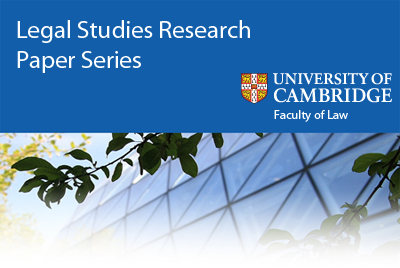 The Faculty has published the first edition of 2014, Volume 5 Number 1 of the University of Cambridge Faculty of Law Legal Studies Research Paper Series on SSRN.
The Faculty has published the first edition of 2014, Volume 5 Number 1 of the University of Cambridge Faculty of Law Legal Studies Research Paper Series on SSRN.
This issue includes the following articles:
Neil H. Andrews: No Longer an Island: European Influence on English Civil Procedure (40/2013)
English civil justice is no longer insulated from external influence. But the strength of that influence ranges from fundamental, to moderate, to the symbolic and hence practically insignificant. First, the most fundamental change occurred when European human rights law induced the UK to destroy the long-standing judicial office of the Lord Chancellor and to replace the Appellate Committee of the House of Lords with the United Kingdom Supreme Court. Secondly, a moderate degree of influence occurred when the European decision in the Gambazzi case (2009) instructed fellow European courts to be wary of over-severe and disproportionate English sanctions against failure to comply with court orders. Thirdly, the European Directive on Mediation (2008), although symbolically influential in some European jurisdictions, was regarded in England as little more than signal the need for Member states to take seriously mediation. Within England the Directive, although not resisted, did little more than make minor adjustments to established mediation practice in the statistically insignificant field of 'cross-border mediation'.
Mark Elliott: The Constitutional Role of the Judiciary if There Were a Codified Constitution (51/2013)
The House of Commons Political and Constitutional Reform Committee is undertaking an inquiry into the constitutional role the judiciary would play if the UK were to adopt a written constitution. (This is part of a wider-ranging inquiry concerning the potential codification of the UK's constitution.) I have responded to the call for evidence that the Committee recently issued when announcing its inquiry into the judicial role. My written evidence to the Committee addresses two of the questions raised in the inquiry's terms of reference, concerning the courts’ present role and their potential role under a codified constitution, and the powers that courts might exercise were they to find legislation unconstitutional.
Brian Cheffins: The Corporate Governance Movement, Banks and the Financial Crisis (56/2013)
This paper discusses why a “corporate governance movement” that commenced in the United States in the 1970s became an entrenched feature of American capitalism and describes how the chronology differed in a potentially crucial way for banks. The paper explains corporate governance’s emergence and staying power by reference to changing market conditions and a deregulation trend that provided executives with unprecedented managerial discretion as the 20th century drew to a close. With banking the historical pattern paralleled general trends in large measure. Still, while the “imperial” CEO who surged to prominence in the 1980s became outmoded for the most part after corporate scandals at the start of the 2000s, this was not the case with large financial companies. The continued boldness of “star” CEOs in the financial services industry plausibly contributed to the market turmoil of 2008 but the financial crisis emphatically ended this corporate governance “free pass” banks had enjoyed.
Alicia Hinarejos: Fiscal Federalism in the European Union: Evolution and Future Choices for EMU (1/2014)
The euro area sovereign debt crisis was, in part, the result of the institutional and legal design of the Economic and Monetary Union (EMU). The crisis highlighted the fact that, for EMU to be fully sustainable as a multilevel system of fiscal and economic governance, it should be able to address the following challenges: (1) enforcing fiscal discipline; (2) addressing structural inequalities between different euro area economies; and (3) preventing and countering asymmetric shocks in an efficient manner. These are challenges that all federal, multilevel or fiscally decentralized systems face when allocating fiscal powers to different levels of government, and when attempting to find a balance between excessive centralization/decentralization.
Over the years, from its creation through the euro area sovereign debt crisis and its aftermath, EMU has evolved to address these problems in different ways. This paper analyses the evolution of the EU’s multilevel system of fiscal governance in relation to these three challenges, showing that they have been only partially addressed. The paper argues that, if it were to address the three highlighted obstacles more fully, the EU would face a crucial choice between two ideal models of fiscal integration: The ‘surveillance model’, where Member States continue to maintain all taxing power and where the EU is an enforcer of discipline, and the ‘classic fiscal federalism’ model, where the EU acquires its own independent sphere of fiscal authority, and thus its own fiscal tools for macroeconomic stabilization. The paper has discussed how to articulate a classic system of fiscal federalism — i.e., where different fiscal functions and instruments are attributed to different levels of government — within the Union, and the problems that this raises.
The main aim of this paper is to provide a clear overview of the obstacles facing EMU and, more importantly, of the two ideal models of further fiscal integration available to the Union. Furthermore, although it may seem counterintuitive, the paper will show that the surveillance model poses just as much of a threat to Member States’ autonomy, and presents us with the same democratic legitimacy problems, as the classic fiscal federalism model. The danger is that, in an effort to avoid the radical changes that come with classic fiscal federalism, the euro area may be edging slowly towards the surveillance model without the necessary awareness and debate.
Matthew Dyson: The Properties of the Law: Restoring Personal Property Through Crime and Tort (2/2014)
Why are the civil remedies at common law which delivery up specific moveable property to another with greater right to possess so narrow in English law? Historically the equitable remedy of specific restoration returned property more easily than even the rule today; the common law remedy remains discretionary, with the claimant having to show the value to the property that cannot be found equally easily in the market.
There may be a number of reasons behind this. The purpose of this chapter is to show the role played by the widely available proprietary remedies in the criminal law, as well as the role of the conceptual structure of property law in England focussing on relative title to possess. The argument being tested is that there was less pressure to develop a civil law restoration remedy because significant practical results were being achieved by the criminal mechanisms. It is all the more interesting that specific restoration has been more significant than compensation in the criminal law (when the reverse has been true in the civil law).
Interested readers can browse the Working Paper Series at SSRN, or sign up to subscribe to distributions of the the e-journal.


 Facebook
Facebook  X/Twitter
X/Twitter  Instagram
Instagram  YouTube
YouTube  Flickr
Flickr  LinkedIn
LinkedIn